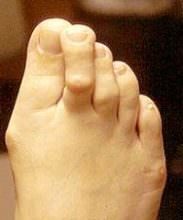What Is A Cross Over Toe?
Table of Contents
Cross over toe describes a condition where a toe(s) become buckled, contracted, or crooked then literally crossed over another toe. The second toe is, by far, the most common to cross over the toe, though any toe could be involved. The second toe will cross over the big toe, and this can happen with bunion problems. Cross over toe occurs from damage to ligaments supporting a toe, causing a muscle imbalance, leading to slow dislocation and crossing over of the toe.
Symptoms Of Hammer Toes
Patients with a cross over toe may develop pain in the entire digit, on the top of the toe, the tip of the toe, and or on the ball of the foot. Excessive pressure from shoes may result in the formation of a hardened portion of skin (corn or callus) on the knuckle and or ball of the foot.
The toes may become irritated, red, warm, and or swollen. The pain may be dull and mild or severe and sharp. Pain is often made worse by shoes, especially shoes that crowd the toes. While some cross over toes may result in significant pain, others may not be painful at all. Painful toes and the bulk of the toe crossing over can prevent you from wearing stylish shoes, or shoes at all.
Causes Of A Cross Over Toe
People are not born with a cross over toe. Rather, it’s a condition that is developed over time. Some people may have a hereditary predisposition. Shoe gear is the most common external factor that will lead to a cross over toe. High heels cause excess pressure on the ball of the foot, leading to injury to the stabilizing structures of the toe. One structure, in particular, called the plantar plate, can become injured – leading to the cascade of toe instability and ultimately cross over toe. A deformed toe often develops over time, and certain types of feet may be predisposed. Some patients may develop a cross over toe just from a bunion problem on the big toe.
When to Seek Cross Over Toe Treatment.
Common reasons patients seek treatment for toe problems are the following:
- Toe pain on the knuckle
- Thick toe calluses
- Interference with walking/activities
- Difficulty fitting shoes
- Worsening toe deformity
- Pain at the ball of the foot
- Unsightly appearance
Toe deformities (contractures) come in varying degrees of severity from slight to severe. They can be present in conjunction with a bunion, and develop onto a severe disfiguring foot deformity. In advanced cases, the toe can dislocate on top of the foot. Depending on your overall health, symptoms and severity of the cross over the toe, the condition may be treated conservatively and/or with surgery.
Non-operative Treatments for Cross Over Toe
Non-surgical methods for cross over toe are geared at decreasing symptoms (i.e., pain and/or calluses) and/or limiting the progression into an even larger problem (if possible).
Simple treatments patients can do are:
- Wear supportive shoes
- Use an arch support
- Wear shoes with a wide toe box
- Modify activities
- Spot stretch shoes
- Periodic callus care
Non-surgical treatments Dr. Delvadia, DPM may add:
- Anti-inflammatory Medicines: Prescription strength medicines to decrease pain and inflammation.
- Physical Therapy: To strengthen poorly functioning muscles and stretch tight muscles that may be exacerbating the toes. Special ultrasound techniques may reduce inflammation.
- Custom Foot Orthotics: Dr. Delvadia, DPM creates an orthotic with an exact mold of your foot to better align and support the foot to ease current discomfort and prevent future progression.
- Toe Splints or Pads: Specific pads may prevent pressure and physical irritation in shoes. Toe splints and toe spacers physically realign the toes and can lessen pain and halt or stall hammer toe progression.
- Injections: Cortisone injections are strong anti-inflammatory agents to decrease pain, and swelling directly at the toe region. Injections only treat the symptoms, and in some cases used in caution (and sparingly), they can further weaken supporting ligaments of the toe(s).
Cross Over Toe Surgery
Cross over toes can be surgically fixed. Depending on the severity and length of the toe, there are several methods to surgically correct a cross over toe. With cross over the toe, however, it’s important to look at the front of the foot as a whole, and consider balancing the foot. In order to properly correct across over the toe, it may be necessary to repair a bunion if the big toe is pushing (or underneath) the second toe.
In general, the surgery involves removing a portion of the bone (within the toe) at the contracted joint, relocating the toe at the ball of the foot, and possibly aligning the toe.
If you’ve been searching for podiatric surgeons for your foot and ankle needs, take time to meet with the Podiatry Group of Georgia. Our doctor has the experience and knowledge you need to help your feet and ankles feel their best. Give us a call today and set up an appointment for your initial consultation. Call us today! Cited: Apma.org
Call Our Marietta, Georgia Office Today at 404-806-3731, or Book your appointment online now!
Proudly Serving Marietta and Atlanta Area!

![podiatryGroup-Logo[1] Logo](https://www.podiatrygroupofgeorgia.com/wp-content/uploads/2020/07/podiatryGroup-Logo1.png)
